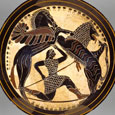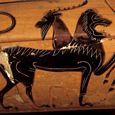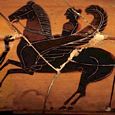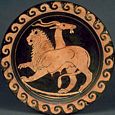The hero Bellerophon was commanded to slay it by King Iobates. He rode into battle against the beast on the back of the winged horse Pegasos and, driving a lead-tipped lance down the Khimaira's flaming throat, suffocated it.
The Khimaira may have once been identified with the winter-rising Constellation Capricorn (the serpent-tailed goat). The constellation Pegasos appears to drive her from the heavens in spring.
Late classical writers represent the beast as a metaphor for a Lycian volcano.
| PARENTS |
| TYPHOEUS & EKHIDNA (Hesiod Theogony 319, Homeric Hymn 3.356, Apollodorus 2.32 & Hyginus Pref & Fabulae 151) |
| OFFSPRING |
| SPHINX, NEMEIAN LION (by Orthos) (Hesiod Theogony 327) |
Homer, Iliad 6. 179 ff (trans. Lattimore) (Greek epic C8th B.C.) :
"First he [Iobates] sent him [Bellerophon] away with orders to kill the Khimaira (Chimera) none might approach; a thing of immortal make, not human, lion-fronted and snake behind, a goat in the middle, and snorting out the breath of the terrible flame of bright fire. He killed the Khimaira, obeying the portents of the immortals."
Homer, Iliad 16. 328 ff :
"Amisodaros, the one who had nourished the furious Khimaira (Chimera) to be an evil to many."
Hesiod, Theogony 319 ff (trans. Evelyn-White) (Greek epic C8th or C7th B.C.) :
"She [Ekhidna] bore the Khimaira (Chimera), who snorted raging fire, a beast great and terrible, and strong and swift-footed. Her heads were three: one was that of a glare-eyed lion, one of a goat, and the third of a snake, a powerful drakon. But Khimaira (Chimera) was killed by Pegasos and gallant Bellerophon. But she also, in love with Orthos, mothered the deadly Sphinx . . . and the Nemeian Lion."
Hesiod, Catalogues of Women Fragment 7 (trans. Evelyn-White) (Greek epic C8th or C7th B.C.) :
"With him [Pegasos] Bellerophon caught and slew the fire-breathing Khimaira (Chimera)."
Homeric Hymn 3 to Apollo 356 ff (trans. Evelyn-White) (Greek epic C7th - 4th B.C.) :
"Phoibos Apollon boasted over her [the Drakaina Python]: ‘. . . Against cruel death neither Typhoeus [i.e. her consort] shall avail you nor ill-famed Khimaira (Chimera) [.e. her child], but here, shall the Earth and shining Hyperion [the Sun] make you rot (pytho).’"
Pindar, Olympian Ode 13 ep 4 (trans. Conway) (Greek lyric C5th B.C.) :
"And [Bellerophon] felled Khimaira (Chimera) breathing fire."
Plato, Republic 588c (trans. Shorey) (Greek philosopher C4th B.C.) :
"One of those natures that the ancient fables tell of, as that of the Khimaira (Chimera) or Skylla or Kerberos (Cerberus), and the numerous other examples that are told of many forms grown together in one."
|
|
|
|




Tidak ada komentar:
Posting Komentar